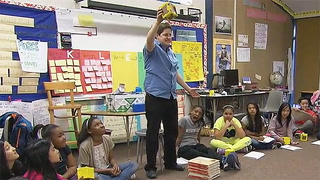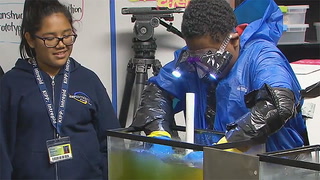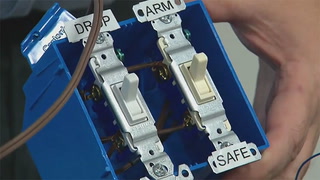Bryan: Wind is on. Eighty-two!
Student: We're going to place sponges on the bottom, so when it drops, it like jumps.
Card:
Engineering Design
In the Classroom:
Rotor Blade Challenge: The
Principles of Lift & Drag.
Bryan: Morning, guys. Good to see you again. Excited to learn a little engineering?
Students: Yeah.
Bryan: All right, all right.
Lower Third:
Tiffani Slaughter
5th Grade Science Teacher
Thurgood Marshall Elementary, Houston TX
+++ 00:00:30 +++
Tiffani: Our lesson today began with students getting background knowledge prior to the lesson, background knowledge on wind turbines.
Tiffani: Let's recap. What have we been working on?
Students: Lift and drag.
Tiffani: We've been working on just lift and drag?
Students: No.
Tiffani: What have been working on? Our whole unit is?
Students: Wind turbines.
Tiffani: Wind turbines, which is a part of?
Students: Alternative energy.
Tiffani: Alternative energy.
+++ 00:00:54 +++
Tiffani: The Boeing project and what drew me to it was actually the STEM component. So when there was an opportunity that I could teach, I could actually create the curriculum with two engineers, and they would actually have to experience the curriculum, that was the driving force in me participating.
Tiffani: Our focus for this unit is alternative energy and we're focusing mainly on building a what?
Students: Blade.
Tiffani: And blade is it?
Students: No. Wind turbines.
Tiffani: We're focused on building wind turbines.
+++ 00:01:24 +++
Tiffani: The first blade design challenge was to just create a blade. We'll test it, we'll see if it works. Then you're going to turn around and create a better blade, based on the information that you gave from your first test and your first trial. So today's lesson is taking that information and using the experience that we have in the room, our two engineers, and gaining knowledge on how to rebuild, how to redesign, how to revamp, how to re-guide your thinking.
+++ 00:01:54 +++
Tiffani: So today we have our engineers with us. Are we excited?
Students: Yes.
Tiffani: Okay.
Lower Third"
Bryan Murphy
Mechanical Engineer
The Boeing Company, Houston TX
Bryan: We love engineering. We love in STEM in general, and then the idea of getting to kind of do science experiments with kids and maybe try to convey some of that joy we have from engineering to the kids just seemed really exciting.
Tiffani: So they are a resource. Does our resource give us the answer?
Students: No.
Tiffani: Our resources are here to help.
Lower Third:
Ian Fialho
Technical Fellow
The Boeing Company, Houston TX
+++ 00:02:22 +++
Ian: We wanted to take the opportunity through this project to try to bring across very fundamentally aerodynamic concepts like lift and drag. So we decided to embed it in a larger project that explored alternative energy forms.
Tiffani: So what occurred yesterday? What do we think worked and what do we think didn't work and why?
Student: What didn't work was our blades, because they were too small, and I think that we used too much heavy material.
Tiffani: Very good observation. Black table?
+++ 00:02:51 +++
Student: Our blades were made of heavy material, which made it not turn, because the heavy material, the wind cannot push that heavy material.
Ian: You guys have hit on something very important, right? When we build airplanes, we try to build airplanes as light as possible, exactly for that reason. So that's a very good lesson you guys learned yesterday.
Tiffani: When I met Ian and Bryan, from day one, the chemistry was there because they have a love. And what I tell them all the time is, you're speaking above my head, so they both know, we have to stop and we have to go back and we have to bring it down, so I could be able to explain it to my students.
+++ 00:03:31 +++
Tiffani: Somebody explain drag to me. Drag to me. Phaedra?
Student: Drag is when the blade is not in the correct angle, so it pushes back and it doesn't rise up.
Ian: The great thing is that they get to take a relatively fundamental engineering or physics idea. In this case, it was lift and drag. And apply that basic physics idea to try to design and optimized and develop something of value.
+++ 00:04:03 +++
Ian: So we're going to try this, okay? You guys can play with this. Change the angle and see how the lift and drag changes. And then we can make a graph of angle versus how fast the turbine spins and we can find out which angle is actually the best angle.
Tiffani: So our goal today is to make sure that our blade designs are better, so we could all have some data to add to our graphs. Are we ready?
Students: Yes, ma'am.
+++ 00:041:32 +++
Tiffani: They're already in groups, groups that were preassigned prior to the unit starting. So once they're in their groups, they know exactly what to do.
Bryan: The test engineer has recorded the data. So what angle do you think you'll set it at?
Tiffani: What are you going to eliminate to make it like different from the design of yesterday?
Student: The end of tape.
Tiffani: We're all facilitating. We're just there as a resource to make sure that we're guiding their thinking. Giving those slight suggestions or posing those questions to actually make them think.
+++ 00:05:04 +++
Ian: So we just want to make it?
Student: A little bit stronger.
Ian: A little stronger so that it doesn't-- when the wind blows on it, it doesn't bend. You want it to try to hold its shape.
Student: That's why we're going to use this type of paper, so it won't bend.
Ian: Okay.
Bryan: When you did yours yesterday, did you use two blades or did you use all three?
Students: All three.
Bryan: You used all three, okay.
+++ 00:05:23 +++
Bryan: Being in the classroom really added a lot of traction to this for both of us. It was obvious that the students had been thinking about this already. They had concepts already down and knew parameters that needed to be changed, and then working from the beginning of the lesson to the end, it was exciting to see just how much more they learned in that timeframe.
Student: Turning 30 degrees, it's like...
Student: It turned a little bit more.
Student: Which is in between this and this.
+++ 00:05:48 +++
Tiffani: Once that's complete, the students get an opportunity to actually use, the test fan, to test their blades.
Ian: Got to check for alignment before we go. Okay. Hand. Your right angle. Okay. Okay, angle.
Student: Angle.
Ian: Good?
Student: Yes.
Ian: Good?
Student: Yes.
Ian: Okay, are we good to test, people
Students: Yes.
Bryan: Activate.
Students: One, two, three, four, five, six, seven, eight, nine, ten.
+++ 00:06:21 +++
Ian: They go through this process where they optimize the design by using a model, which is fundamental to the engineering process. The model in this case was an actual physical model of the hardware. Through the process, they learned to be rigorous. They learn to document failures and successes. They learn to measure things. We had a voltmeter there. They plot things as they go. And then they use reasoning and logic to try to explain why things worked and why things didn't. Another thing that we hope we
+++ 00:06:51 +++
emphasized through it was the ability to communicate and work in teams. All very fundamental to the engineering process.
Bryan: Wind is on.
Students: One, two.
Bryan: Eighty-two.
Ian: Ooh, one, I saw a one, a one.
Bryan: So one, zero, zero.
Ian: I saw a one.
Bryan: One hundred, is that our units?
Student: So seven sixty-eight, six four to seven sixty-six, six three.
Ian: I think we should stop this, okay.
Bryan: Yeah, let's stop.
Ian: This was a good design.
Bryan: Great.
Tiffani: What was your highest?
Student: One point zero.
Ian: One point zero.
+++ 00:07:22 +++
Tiffani: Good job. Give them a...
Tiffani: We finished by sharing out the different findings from each group.
Student: Question: how can I redesign my prototype? Claim: the angle we put was an incorrect angle. It was not tilted enough, like a little bit above zero. Evidence: it went slower than it did yesterday, because yesterday our average was 22. Today it was 16. Reasoning: We should tilt the blades a little more to get a higher number on the voltmeter.
Tiffani: Good job.
+++ 00:07:59 +++
Tiffani: Today I learned that my students were analytical thinkers and they are true engineers in every sense without a degree. I was really at awe with their articulation. I was really at awe with their thinking.
Bryan: Who was an engineer today?
Tiffani: Great job, guys. Gives yourselves a... pat on the back. We need to tell our engineers.
Students: Thank you.
Tiffani: Okay.
GFX:
Teaching Channel
#### End of C0804_002006_Tiffani.FINAL_SD.mp4 ####
















38 Comments
Sara Walther Nov 21, 2017 3:51pm
Lauren Vitiello Nov 21, 2017 11:09am
Michele Kreppein Nov 20, 2017 2:52pm
Stephen DiVisconti Nov 17, 2017 2:30pm
kristina jubinville Nov 17, 2017 9:29am